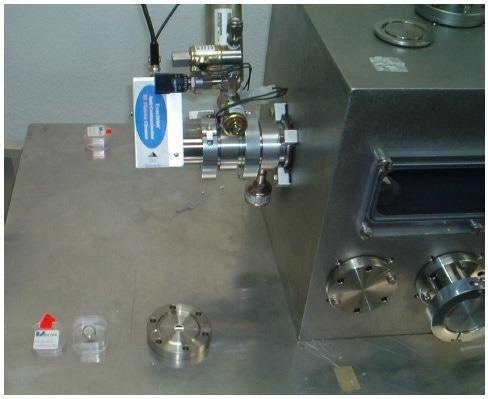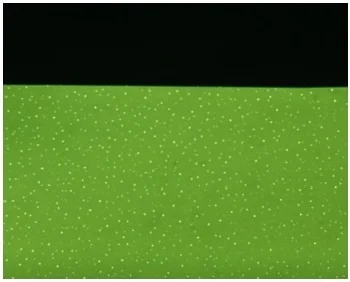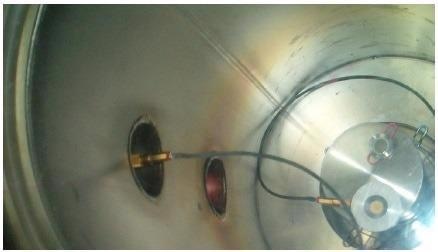When it comes to removing labile hydrocarbon contamination from electron microscope chambers, the Evactron® Anti-Contaminator has been demonstrated to be highly effective.1 Evactron plasma cleaning has also been shown to improve carbon analysis through X-ray spectrometry.2
Operators who have installed EDS detectors on their SEM systems have not reported any failure or damage of X-ray windows from oxygen radicals that tend to develop in the Evactron A-C.
To demonstrate that the Evactron A-C cleaning does not impair the thinnest MOXTEK™ ultrathin window, that is, the AP3.3 EDS window, MOXTEK™ and XEI Scientific had performed window exposure tests to investigate the impacts of Evactron A-C cleaning.
In such tests, a number of AP3.3 were continuously exposed to the oxygen radical flow for 20 to 80 hours for several run periods for a total of more than 160 hours. At the time of these tests, a 500X helium leak detector was utilized to check the windows for any sign of leaks, and light microscopy was also utilized to check for any kind of damage.
The Evactron A-C is a compact RF plasma device that produces oxygen radicals from an air bleed into the Oxygen Radical Source. When placed on an SEM chamber accessory port, the Oxygen Radical Source (ORS) produces localized plasma.
Rather than striking the surface with ions, the ORS plasma cleans through a chemical reaction. The hydrocarbons and organics are ashed into CO, H2O and CO2 molecules by free radicals.
These by-products are then instantly pumped by the roughing pump. And from the ORS, the oxygen radicals flow toward the roughing pump via the chamber by the pumping differential. The Evactron process is quite gentle and thus fulfills the cleaning requirements within the fragile vacuum instruments.
Cleaning with oxygen radicals is quite handy for removing organics in the gas phase and also those, including specimens, that are adsorbed on the walls and other surfaces of the chambers.
The cleaning procedure slowly attacks the polymer films or polymerized and heavily contaminated deposits. The low level of polymer attack is caused by the low concentration of oxygen radicals and the high concentration of C-C single bonds in polymers.
During the mechanism of oxygen radical attack on organic molecules, hydride extraction represents the initial step. This process results in the formation of reactive sites on the carbon skeletons that are prone to more oxidation. If hydride is not extracted, the oxidation of the C-C single bonds in polymers will have a very low reaction rate.
Earlier tests performed on Aluminum (Al) by Walck and team3 using XPS did not indicate any growth of the Al2O3 oxide layer over a brief period of 10 to 20 minutes. The MOXTEK™ windows are coated using the Al film. Any attack on the windows would have to begin with an attack on the Al film. The Al2O3, thus obtained, can powder off and create a hole.
This can be detected by the presence of small leaks visualized by transmission optical microscopy. MOKTEK™ uses optical microscopy and helium leak detection to test windows. All the windows leave the factory with helium leak rates less than the baseline rate of 2.2 x 10−10 mbar L/second.
Experimental Framework
The first three MOXTEK™ AP3.3 EDS Windows were fixed onto a CF 2.75″ flange with a hole in the middle, and the flange was subsequently placed in the Evactron test vacuum chamber, at the same site between each testing period, in the oxygen radical flow.
Since the AP3.3 is the thinnest MOXTEK™ window, it provides the best X-ray transmission of light elements. A 30-nm Al film forms the front surface of the AP3.3 window. It serves as a secondary gas barrier and inhibits photons.
The windows were placed in the region of the highest cleaning oxygen radical concentration in two separate XEI Scientific test chambers, pumped by an oil rotary pump. Test chamber #1 was around 14″ Ø x 16″ in height, while test chamber #2 was an 11″ cube with observation windows placed on the side.
To balance the pressure, the windows were placed on a circular flange with a hole on the backside of the window. The vacuum relief passage has a small clearance to reduce the interaction of oxygen radicals with the backside of the window.
The Evactron A-C was used under XEI Scientific’s suggested operating conditions of 0.6 Torr and 10 W of RF power at 13.56 MHz using room air as the feed gas. The first test window was continuously exposed to the oxygen radical flow for about 30 hours for five run periods and a total of 160 hours.
Additional windows were exposed for extended periods to establish the highest exposure limit.
The windows/flanges were tested for signs of leaks and damage after every exposure to oxygen radical flow. The windows were subsequently tested for a noticeable helium leak, with the limit of detection at 3 x 10−10 mbar L/second.
After exposure to each oxygen radical over the run period, images of the window were also taken and assessed for any sign of damage in the window.
Results
In window 1, a few pinhole light leaks were observed after 40 hours of constant exposure, as shown in Figures 1 and 2. No increase was observed in the size of these light leaks in later examinations at 70, 100, 127 and 160 hours. A slight leak of 0.6 x 10−10 mbar L/second emerged in the first window after a 100-hour exposure.

Figure 1. MOXTEK™ test windows #3 & #4 shown beside test chamber #2. Window #3 is in the CF 275 flange and window #4 is in the MOXTEK™ engineering mount. Both have been exposed to 160 hours of Evactron cleaning and both are helium leak-tight. The Evactron ORS oxygen Radical Source is mounted to the side port of the test chamber. Image Credit: Evactron (XEI Scientific)

Figure 2. A transmission mode micrograph close up of window 1 shows a multitude of small light leaks after the first 40 hours of exposure to Evactron cleaning. No Vacuum leak was found. The light leaks did not change with increasing exposure time and were not repeated on other windows. The dark area is the underlying support grid. Image Credit: Evactron (XEI Scientific)
This was caused by handling damage as identified by the microscopy at MOXTEK™. While the leak was within the quality standards of MOXTEK™, it raised a query about the data.
Although the leak did not worsen with two additional exposures, the testing was ceased on the first window following 160 hours of exposure in favor of testing the second window. All the tests were carried out in test chamber 1.
Following an initial exposure of 40 hours, window #2 was destroyed while transporting it back to MOXTEK™. Window #3 in test chamber 2 was subjected to three exposures as follows: 62 hours, 60 hours and 24 hours (146 hours in total). The Al coating had a small number of light leaks (65) after the final exposure.
No increase was observed in the helium leak. This was the maximum amount of damage seen on any of the test windows and was not performed again on the other windows.
Window #4 and window #5 were placed in smaller MOXTEK™ 'engineering' mounts rather than mounting them on the CF 40 flange. XEI Scientific obtained its own leak detection equipment as well as an optical microscope to expedite the testing process. The exposures were performed in test chamber #1.

Figure 3. Interior of chamber #1 showing Evactron plasma pink glow during Evactron cleaning exposure of window #5. A quartz thin film thickness monitor is also shown in the chamber placed on a pedestal beside the window. Image Credit: Evactron (XEI Scientific)
Window #4 was subjected to 20 hours of cleaning between each analysis through light microscopy. No light leaks were observed until 160 hours of exposure. One pinhole light leak was noted at the 160th hour and no vacuum leak was observed by helium leak detection.
To find out if outcomes are influenced by the length of exposure to Evactron Cleaning, window #5 was subjected to three extended periods of constant exposure. Toward the completion of the first exposure of 66 hours, no pinholes were detected.
After a continuous exposure of another 46 hours, that is, 112 hours in total, no light leaks were detected even after a second analysis was made by rapping the mounting rim to dislocate any loose Alumina from the surface. Light leaks were not detected even after another 48 hours of exposure (160 hours in total).
Discussion
Window failures induced by vacuum leakage did not take place during the testing periods of around 160 hours on all the windows. While the results on window #3 indicate that the duration of Evactron cleaning may influence the speed at which pinholes emerge in the Al coating of the window, the test on window #5 did not prove this outcome.
When compared to shorter exposures, constant Evactron cleaning may lead to additional light leaks in the window and add up to the same exposure. As a matter of fact, constant exposure is likely to be more stringent than numerous exposures for the following three reasons:
- Generally, hydrocarbon contamination is confined inside the chamber by the cold surface of the window. This safeguards the Al window from oxygen radicals at the time of brief cleaning periods.
- Test windows are exposed to higher concentrations of oxygen radicals through constant exposure. Hence, more damage may take place because the contamination of surface hydrocarbons penetrating the vacuum chamber between the sample exchange cycles does not exist.
- Attacks on the Al crystal structure may depend on weak points or openings in the Al2O3 oxide coating. After the exposure to Evactron cleaning is ceased, such weak spots are likely to heal.
The typical mode of failure for MOXTEK™ UTW windows is vacuum leaks. Causes of these vacuum leaks can be established under the microscope by MOXTEK™ Inc. Microscopy effortlessly identifies vacuum failures induced by materials failure, workmanship errors, corrosion, or impacts.
Leak detection is performed on every new window as a part of quality assurance by MOXTEK™ Inc. Except for window #1, none of the Evactron cleaned windows exhibited an increased vacuum leak.
Window #1 demonstrated proof of mechanical damage subsequent to shipping and this was attributed to the slight increase in the rate of helium leak. Besides this, Evactron cleaning did not boost the leak on this window.
While it is not known how much constant Evactron cleaning would be needed to produce a vacuum leak from the familiar polymer decay rates and the emergence of the windows because of Evactron cleaning, XEI believes that it would be well over 200 hours and perhaps over 500 hours of constant exposure.
No specification is available for Light Leaks in MOXTEK™ UTW windows. During Evactron cleaning, light leaks can boost the background on EDS detectors and is likely to expose the underlying polymer film to corrosion.
The host of small light leaks on window #1, perceptible after the initial cleaning, did not increase in size with further cleaning. After the first, many light leaks were observed on window #1 but no such defect was observed on other windows.
These outcomes suggest that if the UTW is subjected to extreme Evactron cleaning, light leaks would certainly begin to appear. The initial indication would be an increase in the background levels in the EDS X-ray spectrum.
Under the usual and recommended operating conditions, the Evactron A-C cleaning cycles have a duration time of 2 to 5 minutes. The number of cleaning cycles varies broadly from SEM to SEM and from one laboratory to another. In a majority of the laboratories, Evactron cleaning is performed only when the quality of an image begins to deteriorate.
In certain cases, Evactron cleaning is performed on a day-to-day basis. Using 5 minutes of cleaning periods, 160 hours of exposure corresponds to 1,920 cleaning cycles. In the case of five SEM operating days per week with one cleaning cycle per day, the overall test period of 160 hours corresponds to 8.7 years of daily exposure of 5 minutes.
Conclusions
After 160 hours of exposure, no adverse effects were noted on the mechanical structure and leak tightness of the four AP3.3 MOXTEK™ windows. Evactron testing time periods were chosen to extend much beyond the usually predicted lifetime of an AP3.3 window at typical Evactron cleaning periods.
To inhibit the accumulation of contamination and retain the quality of the image, the Evactron A-C works 5 minutes a week on a usual analytical SEM. Evactron A-C cleaning may be needed more often in circumstances where the impurity is introduced to the system on a daily basis.
The overall use of Evactron A-C every year would be around 22 hours in the extreme case of day-to-day cleaning at 5 minutes per day. Around 4½ years is needed to realize 100 hours of exposure. MOXTEK™ windows provide a guarantee for 16 months from failures induced by materials and workmanship and generally last for several years prior to replacement.
Although 160 hours of cleaning created light leaks on four varied MOXTEK™ windows, it did not make the windows fail during the vacuum leak tests. The overall test time of 160 hours is much greater than the exposure time a window would experience during its regular Evactron A-C cleaning periods and normal life.
As long as the suggested cleaning practices from XEI Scientific are followed, the Evactron Cleaning can be used safely for MOXTEK™ UTW windows.
XEI Recommendations
XEI Scientific suggests the following cleaning practices:
- Evactron clean only for 30 minutes on a daily basis
- Evactron cleaning should never be used throughout the night
- Evactron clean only when contamination impacts the X-ray sensitivity of light element or the quality of the image
- On SEMs integrated with MOXTEK™ UTW equipped detectors, Evactron clean for five minutes periods or less and vent the chamber between the cleanings
If these suggestions are followed, the UTW window will last its expected normal lifetime of over five years without any problems.
References
- N. Sullivan et al, A STUDY OF THE EFFECTIVENESS OF THE REMOVAL OF HYDROCARBON CONTAMINATION BY OXIDATIVE CLEANING INSIDE THE SEM. Microscopy and Microanalysis 8 (suppl. 2) (2002) 720CD.
- P. Rolland et al, IMPROVED CARBON ANALYSIS WITH EVACTRON PLASMA CLEANING, Microscopy and Microanalysis 2004.
- Walck et al, XPS EVALUATION OF SAMPLES SURFACE CLEANED BY THE XEI EVACTRON®, Microscopy and Microanalysis 7 (suppl. 2) (2001).

This information has been sourced, reviewed and adapted from materials provided by XEI Scientific.
For more information on this source, please visit XEI Scientific.